Rodrigues parrot
The Rodrigues parrot or Leguat's parrot (Necropsittacus rodricanus) is an extinct species of parrot that was endemic to the Mascarene island of Rodrigues in the Indian Ocean, east of Madagascar. It is unclear to which other species it is most closely related, but it is classified as a member of the tribe Psittaculini, along with other Mascarene parrots. The Rodrigues parrot bore similarities to the broad-billed parrot of Mauritius, and may have been related. Two additional species have been assigned to its genus (N. francicus and N. borbonicus), based on descriptions of parrots from the other Mascarene islands, but their identities and validity have been debated.
| Rodrigues parrot | |
|---|---|
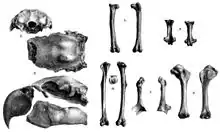 | |
| Subfossil skull and limb bones, 1879 | |
| Scientific classification | |
| Kingdom: | Animalia |
| Phylum: | Chordata |
| Class: | Aves |
| Order: | Psittaciformes |
| Family: | Psittaculidae |
| Genus: | Necropsittacus Milne-Edwards, 1874 |
| Species: | †N. rodricanus |
| Binomial name | |
| †Necropsittacus rodricanus (Milne-Edwards, 1867) | |
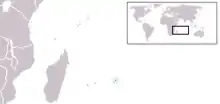 | |
| Location of Rodrigues | |
| Synonyms | |
| |
The Rodrigues parrot was green, and had a proportionally large head and beak and a long tail. Its exact size is unknown, but it may have been around 50 cm (20 in) long. It was the largest parrot on Rodrigues, and it had the largest head of any Mascarene parrot. It may have looked similar to the great-billed parrot. By the time it was discovered, it frequented and nested on islets off southern Rodrigues, where introduced rats were absent, and fed on the seeds of the shrub Fernelia buxifolia. The species is known from subfossil bones and from mentions in contemporary accounts. It was last mentioned in 1761, and probably became extinct soon after, perhaps due to a combination of predation by rats, deforestation, and hunting by humans.
Taxonomy
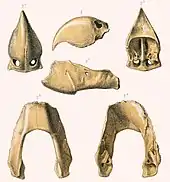
Birds thought to be the Rodrigues parrot were first mentioned by François Leguat in his 1708 memoir, A New Voyage to the East Indies. Leguat was the leader of a group of nine French Huguenot refugees who colonised Rodrigues between 1691 and 1693 after they were marooned there. Subsequent accounts were written by Julien Tafforet, who was marooned on the island in 1726, in his Relation de l'Île Rodrigue, and then by the French mathematician Alexandre Pingré, who travelled to Rodrigues to view the 1761 transit of Venus.[2][3][4]
The Rodrigues parrot was scientifically described and named as Psittacus rodricanus in 1867 by the French ornithologist Alphonse Milne-Edwards, based on a subfossil partial beak.[5] The specific name refers to Rodrigues, which is itself named after the discoverer of the island, the Portuguese navigator Diogo Rodrigues.[6] Milne-Edwards corrected the spelling of the specific name to rodericanus in 1873 (in a compilation of his articles about extinct birds), a spelling which was used in the literature henceforward, but it was changed back to rodricanus by the IOC World Bird List in 2014.[7][8] Milne-Edwards moved the species to its own genus Necropsittacus in 1874; the name is derived from the Greek words nekros, which means dead, and psittakos, parrot, in reference to the bird being extinct.[6][9]
The current whereabouts of the holotype beak are unknown. It may be specimen UMZC 575, a rostrum that was sent from Milne-Edwards to the English zoologist Alfred Newton after 1880, which matches the drawing and description in Milne-Edwards's paper, but this cannot be confirmed.[6] In 1893 the ornithologists Edward Newton (brother of Alfred) and Hans Gadow described more fossils of the Rodrigues parrot, including a skull and limb bones.[10] Remains of the species are scarce, but subfossils have been discovered in caves on the Plaine Corail and in Caverne Tortue.[11]
In the footnotes to his 1873 compilation, Milne-Edwards correlated the subfossil species with parrots mentioned by Leguat.[7] In 1875, A. Newton analysed Julien Tafforet's then newly rediscovered account, and identified a description of the Rodrigues parrot.[12] In a footnote in an 1891 edition of Leguat's memoir, the English writer Samuel Pasfield Oliver doubted that the parrots mentioned were the Rodrigues parrot, due to their smaller size, and suggested they may have been Newton's parakeet (Psittacula exsul).[3] As Leguat mentioned both green and blue parrots in the same sentence, the English palaeontologist Julian Hume suggested in 2007 that these could either be interpreted as references to both the Rodrigues parrot and Newton's parakeet, or as two colour morphs of the latter.[6]
Evolution
Many endemic Mascarene birds, including the dodo (Raphus cucullatus), are derived from South Asian ancestors, and Hume has proposed that this may be the case for all the parrots there as well. Sea levels were lower during the Pleistocene, so it was possible for species to colonise some of the then less isolated islands.[2] Although most extinct parrot species of the Mascarenes are poorly known, subfossil remains show that they shared features such as enlarged heads and jaws, reduced pectoral bones, and robust leg bones.[6] Newton and Gadow found the Rodrigues parrot to be closely related to the broad-billed parrot (Lophopsittacus mauritianus) due to their large jaws and other osteological features, but were unable to determine whether they both belonged in the same genus, since a head-crest was only known from the latter.[10] The British ornithologist Graham S. Cowles instead found their skulls too dissimilar for them to be close relatives in 1987.[13]
Hume has suggested that the Mascarene parrots have a common origin in the radiation of the tribe Psittaculini, basing this theory on morphological features and the fact that Psittacula parrots have managed to colonise many isolated islands in the Indian Ocean.[6] The Psittaculini may have invaded the area several times, as many of the species were so specialised that they may have evolved significantly on hotspot islands before the Mascarenes emerged from the sea.[2]
Hypothetical extinct relatives
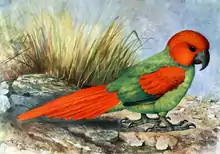
The British zoologist Walther Rothschild assigned two hypothetical parrot species from the other Mascarene Islands to the genus Necropsittacus; N. francicus in 1905 and N. borbonicus in 1907. Rothschild gave the original description of N. francicus as "head and tail fiery red, rest of body and tail green", and stated it was based on descriptions from voyages to Mauritius in the 17th and early 18th century. N. borbonicus (named for Bourbon, the original name of Réunion) was based on a single account by the French traveller Sieur Dubois, who mentioned "green parrots of the same size [presumably as the Réunion parakeet (Psittacula eques eques)] with head, upper parts of the wings, and tail the colour of fire" on Réunion. Rothschild considered it to belong to Necropsittacus since Dubois compared it with Psittacula species, which are related.[6][14][15][16]
The two assigned Necropsittacus species have since become the source of much taxonomic confusion, and their identities have been debated. N. borbonicus later received common names such as Réunion red and green parakeet or Réunion parrot, and N. francicus has been called the Mauritian parrot. The Japanese ornithologist Masauji Hachisuka recognised N. borbonicus in 1953, and published a restoration of it with the colouration described by Dubois and the body-plan of the Rodrigues parrot. He did not find the naming of N. francicus to have been necessary, but expressed hope more evidence would be found. In 1967, the American ornithologist James Greenway suggested that N. borbonicus may have been an escaped pet lory seen by Dubois, since 16th century Dutch paintings show the somewhat similar East Indian chattering lory (Lorius garrulus), presumably in captivity. However, Greenway was unable to find any references that matched those Rothschild had given for N. francicus.[6][17][18]
In 1987, the British ecologist Anthony S. Cheke found the described colour-pattern of N. borbonicus remiscent of Psittacula parrots, but considered N. francicus to be based on confused reports.[4] In 2001 the British writer Errol Fuller suggested Dubois's account of N. borbonicus could either have referred to an otherwise unrecorded species or have been misleading, and found N. francicus to be "one of the most dubious of all hypothetical species".[16] In 2007, Hume suggested that Rothschild had associated N. borbonicus with the Rodrigues parrot because he had mistakenly incorporated Dubois's account into his description of the latter; he stated the Rodrigues parrot also had red plumage (though it was all-green), and had been mentioned by Dubois (who never visited Rodrigues). Rothschild also attributed the sighting of N. francicus to Dubois, repeating the colour-pattern he had described earlier for the Rodrigues parrot, and this led Hume to conclude that the name N. francicus was based solely on "the muddled imagination of Lord Rothschild". Hume added that if Dubois's description of N. borbonicus was based on a parrot endemic to Réunion, it may have been derived from the Alexandrine parakeet (Psittacula eupatria), which has a similar colouration, apart from the red tail.[6][14]
Description
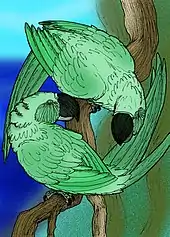
The Rodrigues parrot was described as being the largest parrot species on the island, with a big head and a long tail. Its plumage was described as being of uniform green colouration.[17] Its skull was flat and depressed compared to those of most other parrots, but similar to the genus Ara. The skull was 50 mm (2.0 in) long without the beak, 38 mm (1.5 in) wide, and 24 mm (0.94 in) deep. The coracoid (part of the shoulder) was 35 mm (1.4 in) long, the humerus (upper-arm bone) 53 mm (2.1 in), the ulna (lower-arm bone) 57 mm (2.2 in), the femur (thigh-bone) 49 mm (1.9 in), the tibia (lower-leg bone) 63 mm (2.5 in), and the metatarsus (foot bone) 22 mm (0.87 in).[19] Its exact body length is unknown, but it may have been around 50 cm (20 in), comparable to the size of a large cockatoo.[16] Its tibia was 32% smaller than that of a female broad-billed parrot, yet the pectoral bones were of similar size, and proportionally its head was the largest of any Mascarene species of parrot.[6]
The Rodrigues parrot was similar in skeletal structure to the parrot genera Tanygnathus and Psittacula. The pectoral and pelvic bones were similar in size to those of the New Zealand kaka (Nestor meridionalis), and it may have looked like the great-billed parrot (Tanygnathus megalorynchos) in life, but with a larger head and tail. It differed from other Mascarene parrots in several skeletal features, including having nostrils that faced upwards instead of forwards. No features of the skull suggest it had a crest like the broad-billed parrot, and there is not enough fossil evidence to determine whether it had pronounced sexual dimorphism.[6] There are intermediate specimens between the longest and shortest examples of the known skeletal elements, which indicates there were no distinct size groups.[19]
Behaviour and ecology
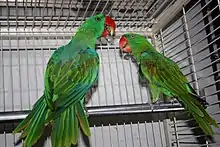
Tafforet's 1726 description is the only detailed account of the Rodrigues parrot in life:
The largest are larger than a pigeon, and have a tail very long, the head large as well as the beak. They mostly come on the islets which are to the south of the island, where they eat a small black seed, which produces a small shrub whose leaves have the smell of the orange tree, and come to the mainland to drink water ... they have their plumage green.[6]
Tafforet also mentioned that the parrots ate the seeds of the shrub Fernelia buxifolia ("bois de buis"), which is endangered today, but was common all over Rodrigues and nearby islets during his visit. Due to a large population of introduced rats on Rodrigues, the parrots, the Rodrigues starling (Necropsar rodericanus), and the Rodrigues pigeon (Nesoenas rodericanus), frequented and nested on offshore islets, where the rats were absent.[6]
Many of the other endemic species of Rodrigues became extinct after the arrival of humans, so the ecosystem of the island is heavily damaged. Before humans arrived, forests covered the island entirely, but very little remains today due to deforestation. The Rodrigues parrot lived alongside other recently extinct birds such as the Rodrigues solitaire (Pezophaps solitaria), the Rodrigues rail (Erythromachus leguati), Newton's parakeet, the Rodrigues starling, the Rodrigues owl (Mascarenotus murivorus), the Rodrigues night heron (Nycticorax megacephalus), and the Rodrigues pigeon. Extinct reptiles include the domed Rodrigues giant tortoise (Cylindraspis peltastes), the saddle-backed Rodrigues giant tortoise (Cylindraspis vosmaeri), and the Rodrigues day gecko (Phelsuma edwardnewtoni).[2]
Extinction
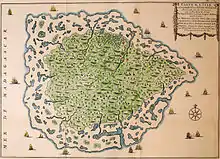
Of the eight or so parrot species endemic to the Mascarenes, only the echo parakeet (Psittacula eques echo) of Mauritius has survived. The others were likely all made extinct by a combination of excessive hunting and deforestation by humans. Like mainland Rodrigues, the offshore islets were eventually infested by rats, which is believed to have caused the demise of the Rodrigues parrot and other birds there.[6] The rats probably preyed on their eggs and chicks.[17] Pingré indicated that local species were popular game, and found that the Rodrigues parrot was rare:
The perruche [Newton's parakeet] seemed to me much more delicate [than the flying-fox]. I would not have missed any game from France if this one had been commoner in Rodrigues; but it begins to become rare. There are even fewer perroquets [Rodrigues parrots], although there were once a big enough quantity according to François Leguat; indeed a little islet south of Rodrigues still retains the name Isle of Parrots [Isle Pierrot].[6]
Pingré also reported that the island was becoming deforested by tortoise hunters who set fires to clear vegetation. Along with direct hunting of the parrots, this likely led to a reduction in the population of Rodrigues parrots. Pingré's 1761 account is the last known mention of the species, and it probably became extinct soon after.[6]
References
- BirdLife International (2016). "Necropsittacus rodricanus". IUCN Red List of Threatened Species. 2016: e.T22728851A94998888. Retrieved 2 January 2020.CS1 maint: ref=harv (link)
- Cheke, A. S.; Hume, J. P. (2008). Lost Land of the Dodo: an Ecological History of Mauritius, Réunion & Rodrigues. New Haven and London: T. & A. D. Poyser. pp. 49–73, 181. ISBN 978-0-7136-6544-4.
- Leguat, F. (1891). Pasfield Oliver, S. (ed.). The voyage of François Leguat of Bresse, to Rodriguez, Mauritius, Java, and the Cape of Good Hope. Volume 1. London: Hakluyt Society. pp. 84–85. Archived from the original on 2016-04-11. Retrieved 2017-02-23.
- Cheke, A. S. (1987). "An ecological history of the Mascarene Islands, with particular reference to extinctions and introductions of land vertebrates". In Diamond, A. W. (ed.). Studies of Mascarene Island Birds. Cambridge: Cambridge University Press. pp. 5–89. doi:10.1017/CBO9780511735769.003. ISBN 978-0-521-11331-1.
- Milne-Edwards, A. (1867). "Une Psittacien fossile de l'Île Rodrigue". Annales des Sciences Naturelles, Zoologie. Series 5 (in French). 8: 145–156. Archived from the original on 2017-10-25. Retrieved 2018-01-13.
- Hume, J. P. (2007). "Reappraisal of the parrots (Aves: Psittacidae) from the Mascarene Islands, with comments on their ecology, morphology, and affinities" (PDF). Zootaxa. 1513: 4–34. doi:10.11646/zootaxa.1513.1.1. Archived (PDF) from the original on 2016-03-21. Retrieved 2013-08-05.
- Milne-Edwards, A. (1866–1873). Recherches sur la faune ornithologique éteinte des iles Mascareignes et de Madagascar (in French). Paris: G. Masson. pp. 23–34. Archived from the original on 2016-10-10. Retrieved 2017-02-11.
- Gill, F.; Donsker, D. (2014). "Parrots & cockatoos". IOC World Bird List. Archived from the original on May 17, 2016. Retrieved February 11, 2017.
- Milne-Edwards, A. (1874). "Recherches sur la faune ancienne des Iles Mascareignes". Annales des Sciences Naturelles, Zoologie. Series 5 (in French). 19: 1–31. Archived from the original on 2017-02-27. Retrieved 2018-02-21.
- Newton, E.; Gadow, H. (1893). "IX. On additional bones of the Dodo and other extinct birds of Mauritius obtained by Mr. Theodore Sauzier". The Transactions of the Zoological Society of London. 13 (7): 281–302. doi:10.1111/j.1469-7998.1893.tb00001.x. Archived from the original on 2017-09-11. Retrieved 2018-01-13.
- Hume, J. P. (2013). Göhlich, U. B.; Kroh, A. (eds.). "A synopsis of the pre-human avifauna of the Mascarene Islands" (PDF). Proceedings of the 8th International Meeting of Society of Avian Paleontology and Evolution: 195–237. Archived (PDF) from the original on 2016-03-03. Retrieved 2017-02-11.
- Newton, A. (1875). "Additional evidence as to the original fauna of Rodriguez". Proceedings of the Zoological Society of London: 39–43. Archived from the original on 2017-10-02. Retrieved 2018-01-13.
- Cowles, G. S. (1987). "The fossil record". In Diamond, A. W. (ed.). Studies of Mascarene Island Birds. Cambridge. pp. 90–100. doi:10.1017/CBO9780511735769.004. ISBN 978-0-511-73576-9.
- Rothschild, W. (1905). "On extinct and vanishing birds". Ornis (Proceedings of the 4th International Ornithological Congress, London). 14: 191–217. Archived from the original on 2017-11-07. Retrieved 2018-01-13.
- Rothschild, W. (1907). Extinct Birds. London: Hutchinson & Co. pp. 61–62. Archived from the original on 2018-05-09. Retrieved 2014-07-25.
- Fuller, E. (2001). Extinct Birds (revised ed.). New York: Comstock. pp. 232–233. ISBN 978-0-8014-3954-4.CS1 maint: ref=harv (link)
- Hume, J. P.; Walters, M. (2012). Extinct Birds. London: A & C Black. pp. 178–179. ISBN 978-1-4081-5725-1.
- Greenway, J. C. (1967). Extinct and Vanishing Birds of the World. New York: American Committee for International Wild Life Protection 13. p. 127. ISBN 978-0-486-21869-4.
- Günther, A.; Newton, E. (1879). "The extinct birds of Rodriguez". Philosophical Transactions of the Royal Society of London. 168: 423–437. Bibcode:1879RSPT..168..423G. doi:10.1098/rstl.1879.0043. Archived from the original on 2016-03-21. Retrieved 2015-08-29.
External links
 Media related to Necropsittacus rodricanus at Wikimedia Commons
Media related to Necropsittacus rodricanus at Wikimedia Commons Data related to Psittaculini at Wikispecies
Data related to Psittaculini at Wikispecies
